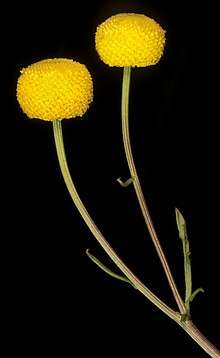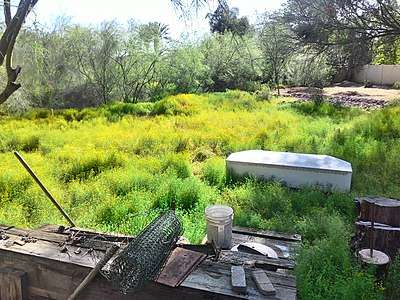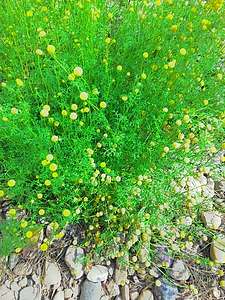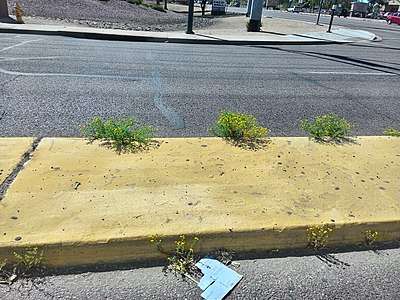Oncosiphon pilulifer
Oncosiphon pilulifer, also known as globe chamomile and stinknet,[2] is a flowering plant in the daisy family (Asteraceae) native to South Africa and Lesotho. It is considered invasive in some parts of North America.
| Oncosiphon pilulifer | |
|---|---|
 | |
| Scientific classification | |
| Kingdom: | Plantae |
| Clade: | Tracheophytes |
| Clade: | Angiosperms |
| Clade: | Eudicots |
| Clade: | Asterids |
| Order: | Asterales |
| Family: | Asteraceae |
| Genus: | Oncosiphon |
| Species: | O. pilulifer |
| Binomial name | |
| Oncosiphon pilulifer (L.f.) Källersjö | |
| Synonyms[1] | |
| |
Other names
Synonyms include Matricaria globifera because it was previously in the Matricaria genus, and Pentzia globifera, named for 18th century Swedish botanist Carolus Johannes Pentz.[3]
The common name "stinknet" reflects the plant's strong odor.
Description
Globe chamomile is a straggly, branching annual plant with a strong smell, growing up to 2 ft (60 cm) tall. The bipinnate or tripinnate leaves have a fleshy midrib which widens at the base. The globular flowers are borne in paniculate flower heads. There are no ray florets and the disc florets are yellow.[4]
Ecology
Globe chamomile is native to South Africa and Lesotho.[1] It is also found in the Australian states of Victoria and Western Australia.[3]
In North America, globe chamomile grows from seed in November to January when it begins flowering and setting new seeds. With sufficient moisture, three generations can grow by April. Wind-borne seed transportation spreads the plant which takes root in sunny, disturbed soil in natural and cultivated areas. Plants can cause skin irritation or allergic reaction through contact with the plant or inhalation of its pollen.[5]
A single plant can contain up to 4000 flower balls, each ball being made up of hundreds of flowers.[6]
Invasiveness in the United States
Globe chamomile is considered invasive in the United States in California and Arizona. First seen in Los Angeles and San Diego in the early 1980s, it heavily infests the counties between those cities.[2] It expanded its range to the Phoenix area in the first decade of the 2000s[6][5] and can be found in Maricopa, Pinal, and Pima counties.[2] Rapid spread in Maricopa County occurred due to above-average fall and winter precipitation in 2016, and 2018–2020. Heavy infestations occurred in northern parts of Phoenix and Scottsdale as well as to the south along the I-10 corridor towards Casa Grande. The first recorded growth in Tucson was in 2015.[2]
The plant can be removed physically or killed with triclopyr; it is resistant to glyphosate-based herbicides.[4]
The Arizona department of Agriculture considers it a "high priority pest for quarantine, control or mitigation if a significant threat to a crop, commodity, or habitat is known to exist."[6] Other problems are its density which displaces native vegetation, high flammability of dried-out patches, and caustic smoke when burned.[2]
Conservation status
Globe chamomile is a species of "least concern" (low conservation concern) in South Africa.[7]
Gallery
 Invasive growth in Arizona
Invasive growth in Arizona Plant in bloom
Plant in bloom Growing along street in Phoenix, Arizona
Growing along street in Phoenix, Arizona
References
- "Oncosiphon pilulifer (L.f.) Källersjö". Plants of the World Online. Royal Botanic Gardens, Kew. Retrieved 4 April 2020.
- "Stinknet (also called Globe Chamomile) - (Oncosiphon piluliferum)". sdcwma.org. Sonoran Desert Cooperative Weed Management Area. Retrieved April 4, 2020.
- "Globe Chamomile". herbguide.com.au. Retrieved April 4, 2020.
- "Globe Chamomile - A Threat Spreading Quickly" (PDF). aznps.com. Arizona Native Plant Society. Retrieved April 4, 2020.
- DuHarnel, Jonathan (April 27, 2019). "Globe Chamomile, an invasive species in Arizona". Arizona Independent News Network. Retrieved April 4, 2020.
- Woods, Alden (Apr 10, 2019). "Instagram-friendly flowers are taking over the Phoenix area. One problem: They're invasive weeds". Arizona Republic. Retrieved April 4, 2020.
- Foden, W. & Potter, L. 2005. Oncosiphon piluliferum (L.f.) Källersjö. National Assessment: Red List of South African Plants version 2017.1. Accessed on 2020/04/04